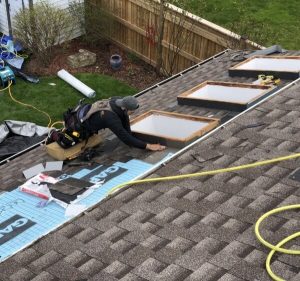Everything You Need to Know About Leaf Guards
Aug 19, 2023

Rain gutters are crucial for directing rainwater away from your house; without them, water falling directly from the roof can destroy the house’s foundations as the areas surrounding the house are eroded. But gutters are easily clogged, particularly in the fall, where leaves and other debris can quickly build up and block the passage of the water. Gutter maintenance is neither easy nor fun, so gutters need to be covered to prevent them from getting filled up. This is where leaf guards come into play: allowing the water to move through the gutter while stopping more solid objects like leaves and twigs from impeding the flow.
Leaf Guards Through the Ages
For many years, homeowners have attempted to keep their gutters free from debris. Many types of leaf guards have been tried over the years and have failed for one reason or another. Old-style plastic and metal mesh leaf guards tended to have holes that were far too big, meaning that they were both prone to letting debris through and were also hard to clean. This could result in extra work, or extra charges from gutter-cleaning companies. It’s little wonder that people are suspicious of leaf guards! But lately, there have been many advances in leaf guard technology that solve many of these issues.
Some of the best recent designs use highly engineered fibrous material that acts as a very good filter, or powder-coated stainless steel wrapped in a mesh for unprecedented performance. Of course, such products are expensive. Below, we outline some features of different mid-range materials that do not break the bank but can still do a great job of keeping your gutters free from debris. These designs include leaf gutter guards, which consist of aluminum plates with small holes, and foam gutter guards, which use foam blocks for better filtering.
A Material Difference
There are several types of mid-range leaf guards on the market at the moment, made with various different materials:
- Leaf gutter guards are created of a simple aluminum sheet than has the prefect size of holes to prevent leaves and debris from entering the gutter while draining large amounts of water. However, this design requires professional installation, but is backed by a 40-year clog-free warranty.
- Foam gutter guards are cheap and you can install them yourself, but they need to be regularly maintained and replaced as they are strongly affected by weathering and clogging. Like leaf gutter guards, they block large debris but can be clogged by small particles.
- Rain gutter guards use vinyl panels with a flat stop on top to form drainage channels. They can filter out both small and large debris, and you can install them yourself, but they clog easily, and the vinyl is not strong enough to stand up to snow and can be damaged by UV rays from the sun.
Leaf Guard Myths Debunked
A substantial minority of people don’t believe that leaf guards work at all, or that they’re more trouble than they’re worth. Not true! Often the problems homeowners complain about with leaf guards were always there, it’s just that nobody noticed until the gutters were actually inspected. The most common complaint is about icicles: people claim that they’ve never had ice dams until the leaf guard was installed, but really they may have been there all along but nobody bothered to check! After all, open gutters get icicles too.
What about problems with water concentration points? Often, valleys on roofs allow water to form streams that run deeper and faster than the rest of the roof, and can overshoot gutters entirely. Leaf guards can be designed to deal with this problem, depending on water volume and tree type. Finally, some people feel that leaf guards trap too much soggy debris when it rains, meaning that the guttering system doesn’t work properly as the debris has no time to dry out and blow away. However, modern leaf guard designs ensure that water gets around debris effectively, the filter has the ability to self clean and the wind can be used to get the debris out of the system.
With this information, you should be able to make an informed choice about your leaf guard options, and hopefully reduce the time spent cleaning out those gutters!




